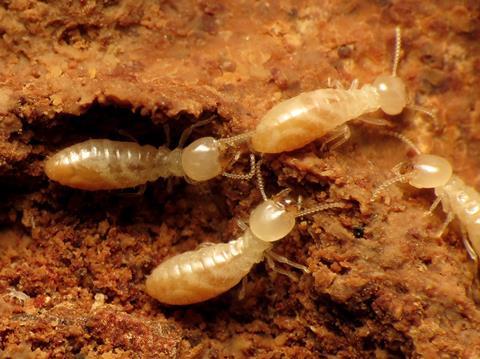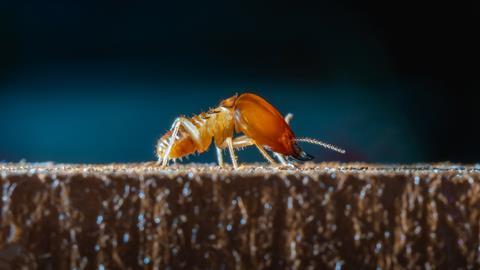Whilst termites are infamous for causing economic damage and destruction of property, their ability to naturally produce hydrogen is virtually unheard of, even though they already produce around 200 million tonnes of hydrogen annually. Given that termites consume cellulose in the form of wood, paper, cardboard, and cotton, a circular economy can be created for waste products, which are often just sent to landfills or combusted, adding significant promise to the prospect of termite hydrogen.
Termites produce hydrogen via certain bacteria in their digestive tract, such as Enterobacter cloacae KBH3, Clostridium sporogenes, Clostridium agropyri, and Clostridium termitidis, which ferment the cellulosic matter and produce the hydrogen. It is important to note that, as with all complex organisms, contained within them are entire microbiomes, where the hydrogen-producing bacteria are just a part. This is highlighted by one study that found that administering termite feed with certain antibiotics (tetracycline and ampicillin) actually increased hydrogen production by 6-7 times. It is worth noting that both tetracycline and ampicillin resulted in significant hydrogen increases, even though tetracycline specifically is known to inhibit hydrogen-consuming methanogenic bacteria, which the paper suggested may mean that methanogenic bacteria may not be a major obstacle to hydrogen production. It stands to reason that if antibiotics have been found to improve hydrogen production, then engineered usage of pheromones could also increase the feeding and reproduction rate. The optimisation potential seems boundless!

The mention of the termite’s hydrogen-producing gut microbiome naturally raises the question of whether it would be more feasible and less risky to isolate and culture the microbiome outside the termite. However, initial studies have found that one prevalent challenge for large scale isolated-Bacteria-Hydrogen-Production (known as dark fermentation) is the high cost of pre-treatment for the cellulose substrate, which is most likely naturally achieved with termite saliva. Complex bioreactor design for isolated bacteria has also been cited as a drawback for dark fermentation, whereas termites are essentially pre-existing small and well-designed bioreactors, having evolved and iterated for around 250 million years, enabling them to produce 200 million tonnes of hydrogen a year naturally.
Termite hydrogen is a highly multidisciplinary research avenue combining chemical engineering, zoology, and microbiology, and warrants a combined global effort to delve into the multitude of termite species (2972) and variables to experiment with. So far, only 5 species have been confirmed to produce hydrogen, with no available studies being found to disconfirm hydrogen production in a species (at this time of writing). That’s 5 down, 2967 to go!
One study on hydrogen production from Psammotermes hybostoma (aka the Sand Termite), found that a 15cm high 5cm radius cylindrical enclosure housing 350 termites fed on cardboard produced 0.326ml of hydrogen per termite per day, at an average temperature of around 30°C. Scaling this up (and using a cuboid-shaped enclosure instead of a cylinder), a 14m3 or 2m wide by 2m long by 3.5m high enclosure housing around 4.2 million termites fed with cellulosic matter infused with the antibiotics, can produce enough hydrogen to meet the average American household’s energy consumption of 30kWh per day. Considering the average American house takes around 204m2of land, a property with the same area (i.e., one average American house worth of land) can house 51 of these units, and thus produce enough hydrogen energy for 51 houses. Opting for a larger height and smaller land area for the enclosure can improve the spatial efficiency. It is important to note that not all termites produce mounds, and many simply just live in soil, and that a soil-filled cuboid enclosure could suffice. Whilst this calculation is subject to a lot of assumptions (such as whether the antibiotics are cost effective to make at large scale, whether they’ll have a similar effect on other species, and whether the space larger termite colonies need scale up linearly), it is certainly indicative of the monumental potential held by termite hydrogen.

Termites also produce two valuable side products: eggs and nutrient-rich soil. The eggs can be used as poultry and fish feed in place of the commonly used soymeal, which is a very significant contributor to deforestation, and therefore, climate change. In essence, Termite ‘farming’ for hydrogen, eggs, and soil could very much be a three-pronged solution to climate change, providing energy and food, and playing a part in reversing deforestation. On a slightly fun note, termites are anecdotally reported to taste fruity or nutty, so perhaps poultry and fish fed on termite eggs can follow in the vein of Olive Wagyu for unique tasting meat and seafood! Some termites are even known to cultivate their own edible mushrooms known as Termitomyces, known for their smoky and meaty taste.
The positive implications of termite hydrogen don’t stop there: unlike petroleum, termite hydrogen is replenishable, and when knowledge of termite breeding advances, any country on the planet can grow and sustain their own termite hydrogen farms and achieve better energy independence, thus avoiding the geopolitical complications presented by petroleum, to at least some extent. However, that’s not to say that some countries won’t benefit from termite hydrogen in particular. The research could pave the way for the extraction of hydrogen from existing colonies in the wild, most of which are found in tropical and subtropical regions, where most countries are still developing, and below the Brandt line. The largest known termite mound in the world is located in Brazil and covers an area around the size of Great Britain. This would very much make termite hydrogen the newer and better natural gas!
Termites could be the gift that keeps on giving if we let them spoil us a little!

Addressing some of the (mitigatable) drawbacks of termite hydrogen
Although termites do produce carbon dioxide, it’s clean and produced at low temperatures (20-35°C), so can likely be used for carbon sequestration for enhanced crop growth.
As mentioned earlier, termites do produce methane, but such methane can be separated from the hydrogen, in addition to the fact that combustion of any methane produces over three times as much energy as the combustion of the same molar amount of carbon monoxide, whilst producing the exact same molar amount of carbon dioxide – as both species have exactly one carbon atom per molecule. Carbon monoxide is produced alongside hydrogen in the steam reformation of methane, the current most common means of hydrogen production, where both species are commonly combusted as part of a mixture known as syngas. Also mentioned earlier was the suppression of methane-producing bacteria via antibiotics, improving the potential sustainability of termite hydrogen even further.
Whilst the obvious ecological risks of termites naturally raise concern, it is important to note that research into more advanced containment methods can take place. Termites cannot climb smooth glass, are mostly photophobic, die under excessive exposure to sunlight, and cannot swim. Even something as simple as a moat with bright lights around their enclosure could work. It is worth noting that although one termite infestation has happened in the UK, as a result of the accidental introduction of some Reticulitermes grassei from the Mediterranean, the infestation was confined to one single property in Devon and did not spread past it for 21 years. This may suggest that termites in a hydrogen production facility may stay confined to their enclosure (whose conditions are well suited to their needs and stocked up with food), even if some kind of opening for escape did occur. Interestingly, research on termite hydrogen involving pheromones could one day extend to engineered usage of pheromones to lure termites away from residential areas and towards modified enclosures where their hydrogen can be collected. A real win-win situation!
Compared to the steam reformation of methane and electrolysis for hydrogen production, termite hydrogen is potentially a much simpler, more self-sustaining, non-polluting, and less energy-intensive way of producing hydrogen. Whilst there may be questions and reservations about how feasible it is for termite hydrogen to produce enough energy on a global scale, it is very important to wait for data to be collected, simulations to be run, and cost analyses to be completed before jumping to conclusions, as we may well be pleasantly surprised when the dust begins to settle. After all, termites do already naturally produce 200 million tonnes of hydrogen a year. In 2022, the demand for hydrogen was 95 million tonnes, which is expected to grow to 450 million tonnes by 2050.
It is important to note that such a comparison is not to suggest that somehow all of the 200 million tonnes of hydrogen per year from wild termites can be harvested, but is simply meant to highlight the immense potential for hydrogen production via a combination of captive termite hydrogen production (possibly with optimisation from antibiotics etc), and wild termite hydrogen extraction.
Studying termite hydrogen
The plan for my PhD in termite hydrogen is as follows:
- To explore the viability of an experimental setup that allows for the chemical activity of termites to be fully quantified. This includes the reaction stoichiometry, and reaction kinetic data (reaction orders, activation energy, Arrhenius constant, heat of reaction, etc).
- To explore the viability of an experimental setup that allows for the termite population dynamics to be accurately modelled as functions of ambient conditions (temperature, gas concentrations, etc), available feed, and space.
- To simulate a termite hydrogen plant in chemical process modelling software and compare the sustainability to pre-existing hydrogen production methods.
The findings from the PhD can be used and replicated around the world to assess the viability of termite hydrogen from more of the 2972 species, and maybe even discover something unexpected, in the same vein as infusing termite feed with antibiotics.
However, this can only happen if researchers around the world are informed about the field, which is virtually unheard of, so sharing this article with as many people as you can will be instrumental in turning the tide against climate change. Something as small as a share can have a huge ripple effect and play a huge part in paving the way for a better future. We can do this, so let’s do it.
Watch a YouTube video made by the author about this research below.








No comments yet